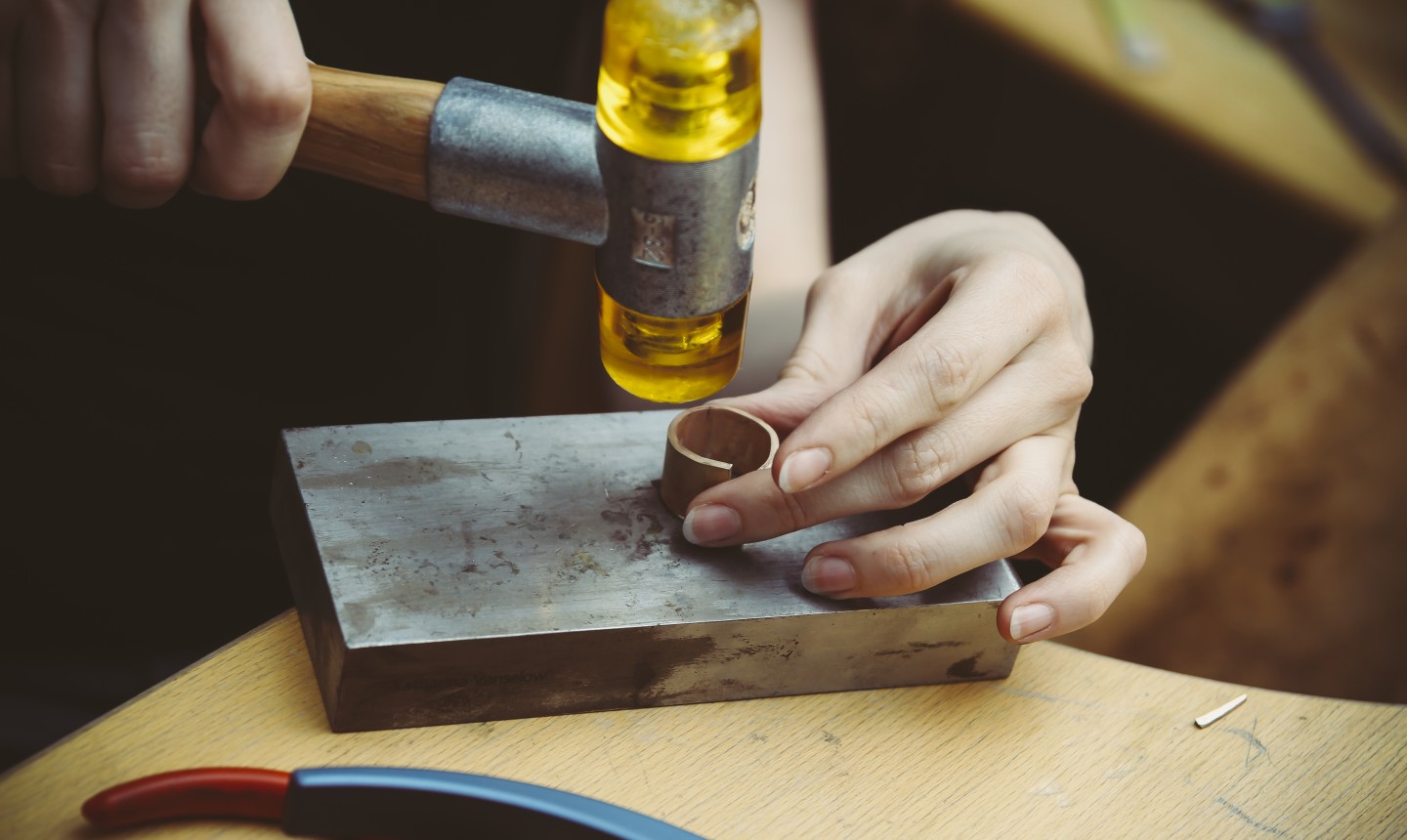
Getty Images/Westend61
The best part about metalsmith jewelry is the wide variety of materials you get to work with. Whether you’re looking to handle silver, gold, rose gold, base metals or more specialized metals, stick with us for the rundown on the most common types of metal for jewelry making.
1. Silver
When you’re talking about jewelry, you’re talking about sterling silver. That just means it’s 92.5 percent silver and 7.5 percent copper. Sterling silver is a great option because it’s durable and long lasting, so it’s good for rings, necklaces, bracelets, cuff links, belt buckles, body jewelry… you get the picture. But keep in mind that silver jewelry is softer than gold, platinum and titanium, and it’s likely to tarnish without proper care.
2. Silver-filled
Silver-filled metals (AKA “silver overlay”) are another popular choice. The difference is that silver-filled wire is made by using heat and pressure to apply a layer of silver to a base of a cheaper metal.
This silver layer is seriously hundreds of times thicker than a standard plating. Because it’s so thick, it lets you work deeper, polish more and even do some light engraving without exposing the base metal underneath.
Silver-filled makes sense for jewelry components like ear wire and chains. It keeps them affordable, plus they’ll last forever and look spot on when paired with sterling silver pendants.
3. Gold

Westend61/Getty Images
Gold jewelry is a mix of gold and other metals, such as silver, copper, nickel and zinc. When you’re talking about the actual gold content, it’s measured in Karats (K) or carats (ct). That just describes the proportion of pure gold to the other metals in the material. The higher the proportion of gold in the final metal, of course, the more $$$ you’ll have to thrown down for it.
The maximum gold content is 24K, which would make for terrible jewelry because 24K gold is soft and malleable. Look at 14K gold for jewelry — it’s strong and easy to work with. Or, if you’re feeling spendier, try 18K gold (75 percent pure gold).
Pure gold is yellow in color and, since you won’t be buying that, it’s the non-gold metals used in the alloy that ultimately determine the color of this metal.
- Yellow gold is the alloy of pure gold, silver and copper or zinc.
- White gold is the alloy of pure gold and white metals, such as nickel, silver and palladium. It is actually more grayish in color and is plated with rhodium to give it a whiter look. Nickel is generally avoided today since so many people are allergic to it.
- Rose gold is the alloy of pure gold and a high proportion of copper.
- Green gold is exactly like yellow gold, except copper is left out of the alloy.
In any of its variations, gold is a popular choice for things like wedding bands, rings, earrings and necklaces.
4. Base Metal

Westend61/Getty Images
Base metals include iron, nickel, copper, brass and titanium, among others. These metals are abundant and can oxidize or corrode pretty easily, but they make beautiful hammered disc pendants.
5. Platinum
Platinum is the rarest and most expensive of the metals. But the price is justified since it’s super durable and will never tarnish. Pure platinum melts at 3,216.2 degrees Fahrenheit, so unless you’re, you know, literally spending time on the sun, it’ll work great for things like wedding bands and cuffs.
Appearance is everything, so platinum is often alloyed with copper and cobalt to give it a different look. Plus pairing it with other metals makes it even more durable. If you’re looking for other “platinum group” metals, check out ruthenium, rhodium, palladium, osmium and iridium.
6. Titanium
It doesn’t get stronger than titanium. It’s the hardest natural metal known to man, putting steel, gold, silver and platinum to shame. Plus It’s scratch-resistant, lightweight and easy to color.
Titanium is even completely hypoallergenic, which makes it popular for body-piercing jewelry and even surgical implants. Just don’t use this wonder-metal for making rings — your fingers change size over time (weird, right?), and titanium isn’t solderable or resizable.
The durability of sterling silver is second to none. It can last between 20-30 years if cared for properly, and it'll be good as new long after you've passed on! You might think that an occasional wearing would short out this type jewelry but studies show they're actually more durable than many people realize
your blog is very important for learning to how make jewelry. and we deals in photo projection Jewelery gifts,custom projection keychain online. For more info visit our website today.
wow this is a best and good informative site because now a days we all know how much the silver and gold are diamonds are important about very fashioned and style this craftsy website is a best site to know about naturel rings and jewelries thank you so much craftsy for knowing about this accessories
Wanting to make our own rings valentine's coming. Valued customer, 316 e Braxton street, Paoli Indiana 47454. Home address
I really like how straight forward this article was, exactly what I was looking for! I can now move forward with my project knowing what metal is best for what I am doing.Thank you :)
What Materials Use Making Titanian Braslete
Very good
I love statement jewellery pieces… Loved how you suggested Different ones
Is Titanium shinny black and does it tarnish?